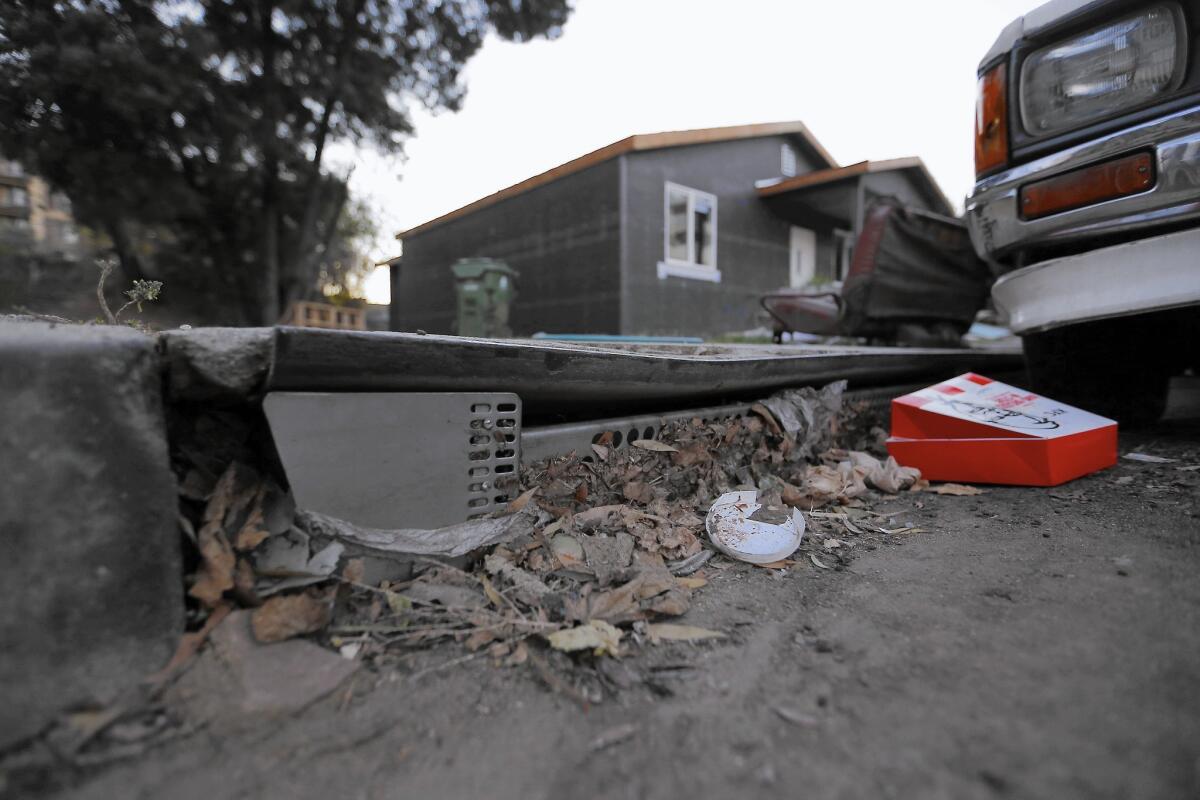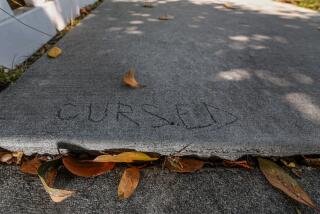First & Spring: Looming rains could turn L.A.’s roadside trash into a hazard

Boyle Heights resident Maricela Navarrete got home from work three months ago to find a neighborhood partly under water.
A sudden downpour had dropped an inch of rain in 30 minutes, leaving her street looking “like a small lake,” she said. Cars on the street were partly submerged. Her family’s basement took on 5 feet of water, ruining clothing, furniture and an album of her niece’s wedding photos.
City officials say the flood that hit Bernal Avenue on Oct. 19 was triggered, in part, by a mattress, plastic bags and other garbage that clogged nearby catch basins. Those metal openings, located at the curb and gutter, typically allow rainwater to wash into underground storm drains before heading to the ocean. On Bernal, the water had nowhere to go.
Water and Power is The Times’ guide to the drought. Sign up to get the free newsletter >>
L.A.’s proliferation of roadside garbage — abandoned couches, futons and other items left on public property — resurfaced in 2014 as a major topic of concern for city leaders. But with El Niño and the prospect of heavy rains looming, it turns out the trash isn’t just considered an eyesore. It’s also a potential public safety risk, said Adel Hagekhalil, assistant director of the city’s Bureau of Sanitation.
El Niño is going to expose the deteriorated state of the infrastructure.
— Mike Eveloff, board member, Fix The City
So far this rainy season, sanitation crews have cleaned all 40,000 of the city’s catch basins and removed debris from the screens that frequently cover the openings. Still, those catch basins could be blocked again the next time a torrential rain washes sopping wet seat cushions, construction debris and other items into the gutters.
In recent weeks, Hagekhalil has been promoting the sanitation bureau’s 24-hour hotline, (800) 773-2489, as a way for the public to report illegal dumping and jammed-up catch basins. Because of El Niño, the hotline’s hours were expanded, he said. “We are looking at areas that are susceptible to flooding, and we are dependent on people calling us and letting us know,” he said.
Los Angeles has struggled for years to get a handle on its trash situation. A report prepared in 2014 concluded that city streets, sidewalks and alleys were so strewn with garbage that the situation threatened L.A.’s international image. In August, an investigation by The Times found that from January 2010 to June 2015, city crews did not respond to more than a third of requests made for removal of illegally dumped items in parts of central, northeast and South L.A.
During that period, 40% of illegal dumping complaints went unanswered in the 400 and 500 block of Bernal, according to city data analyzed by The Times.
Sanitation officials reported last month that crews had cleared the citywide illegal dumping backlog. Still, Bernal Avenue is not the only place to experience problems with its drains.
On the day Navarrete’s basement flooded, a catch basin also backed up at 1st and Cummings streets, in a section of Boyle Heights next to the 5 Freeway. The water level at that intersection soon rose above the sidewalk. Workers at a Farmers Insurance office, located right on the corner, were forced to grab brooms to push the water away from desks and back out the door, said Robert Lopez, a tax preparer who works there.
City officials later revealed that a construction barricade and trash had blocked a catch basin at that intersection — news that did not surprise Lopez.
“Our corner always gets flooded, and the water goes into the office every year,” he said.
Sanitation officials say they clean every catch basin twice a year — once in the dry season and again in the rainy season. Those that are considered flooding hazards get additional visits. Although 25 two-person crews are typically available citywide to perform the work, city leaders can increase that number to 100 in advance of a major storm, Hagekhalil said.
Still, even with clean catch basins, L.A.’s storm drain system is not capable of handling a storm that produces more than an inch of rain per hour — the type that hit Boyle Heights in October, Hagekhalil said.
Join the conversation on Facebook >>
Sanitation officials have prepared a list of construction projects that would reduce the threat of flooding. Those projects — including replacement of dozens of storm drains — are expected to cost nearly $727 million.
That wish list “didn’t happen overnight,” said Mike Eveloff, a board member with Fix The City, a nonprofit group that has criticized the city’s failure to maintain its streets, sewers and other public works. Those public works projects show how vulnerable L.A. could be in the next major storm, he said.
“El Niño is going to expose the deteriorated state of the infrastructure,” Eveloff added.
Meanwhile, even though city crews have been removing garbage from catch basins, they haven’t necessarily addressed the trash that’s scattered nearby.
On Cummings Street just south of 1st, sidewalks were littered last week with newspapers, boxes and a sawhorse owned by the city’s Bureau of Street Services. Those items could pose a problem in the next rain.
On Bernal Avenue, the flood that hit three months ago damaged a dozen cars, according to city officials. Yet plenty of large abandoned items could be seen in the area last week, including orange foam, part of a toilet and two shopping carts, one filled with rolls of Christmas wrapping paper.
“It’s a daily, daily thing, constantly picking up everything” on the street, Navarrete said. “People are not conscious of the damage that they’re doing.”
An especially messy lot near Navarrete’s home is owned by the city. Last week, that weed-filled hill had an assortment of cups, fast food wrappers and a door — exactly the kind of object that Hagekhalil does not want floating down the street and blocking a storm drain.
After The Times asked about that empty lot, city crews went to the site and removed the weeds, the trash and the door.
Times staff writer Ben Poston contributed to this report
ALSO
Venice tenants complained to the city, then wished they hadn’t
Are SeaWorld’s whales better off staying in their glass-and-concrete enclosures?
Will this year’s Academy Awards see a repeat of #OscarsSoWhite backlash?
More to Read
Sign up for Essential California
The most important California stories and recommendations in your inbox every morning.
You may occasionally receive promotional content from the Los Angeles Times.











